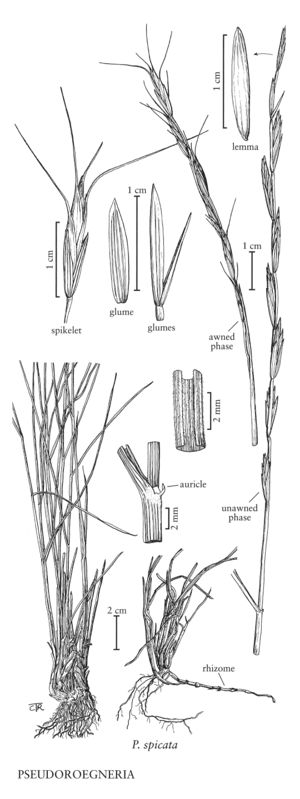| Taxon | Illustrator ⠉ | |
|---|---|---|
 | Pseudoroegneria spicata | Cindy Roché |
Plants perennial; usually cespitose, sometimes rhizomatous. Culms 30-100 cm, usually erect, sometimes decumbent or geniculate. Leaves evenly distributed; sheaths open; auricles well developed; ligules membranous; blades flat to loosely involute. Inflorescences terminal spikes, erect, with 1 spikelet per node; internodes (7) 10-20 (28) mm at midlength, lower internodes often longer than those at midlength. Spikelets (8) 12-25 mm, 1.1-1.5 (2) times the length of the internodes, usually appressed, sometimes slightly divergent, with 4-9 florets; disarticulation above the glumes and beneath the florets. Glumes unequal, from shorter than to slightly longer than the lowest lemma in the spikelets, lanceolate to oblanceolate, (3) 4-5 (7) -veined, usually acute to obtuse, occasionally truncate, narrowing beyond midlength, veins prominent; lemmas inconspicuously 5-veined, unawned or terminally awned, awns straight to strongly bent and divergent; anthers 4-8 mm. x = 7. Haplome St.
Distribution
Ariz., Colo., N.Mex., Tex., Mont., Nev., Oreg., Utah, Alaska, N.Dak., Nebr., Mich., Idaho, S.Dak., Wyo., Wash., Alta., B.C., Sask., Yukon, Calif.
Discussion
Pseudoroegneria includes 15-20 species, one of which is North American and the remainder either Eurasian or Asian. All species currently included in the genus are obligate outcrossers, and almost all are diploids or autotetraploids (Jensen et al. 1992) containing the St haplome (designation by the International Triticeae Consortium). This genome is the most widely distributed in the Triticeae, being found in all species of Elymus sensu lato as well as some species of Thinopyrum.
The limits of Pseudoroegneria are not well established, whether it is treated as a genus, as here, or included in Elytrigia (Tsvelev 1976) or Elymus (Melderis 1980). Two species that were originally included have been transferred to Douglasdeweya C. Yen, J.L. Yang & B.R. Baum (Chen et al. 2005), because specimens grown at agricultural experiment stations were found to be StP allotetraploids (Jensen et al. 1992; Wang et al. 1986; Chen et al. 2005).
There are also questions concerning the delimitation of species in Pseudoroegneria. For instance, Jensen et al. (1995) suggested that P. spicata, P. strigosa (M.-Bieb.) Á. Löve , P. geniculata (Trin.) Á. Löve , P. elytrigioides (C. Yen & J.L. Yang) Bao-Rong Lu, and Roegneria glaberrima Keng & S.L. Chen [Elymus glaberrimus (Keng & S.L. Chen) S.L. Chen] should be considered members of a single transberingian species complex. They presented cytological, but not morphological, analyses supporting this conclusion.
Selected References
Lower Taxa
"decumbent" is not a number."-1.5(2)timesthelengthof" is not declared as a valid unit of measurement for this property.